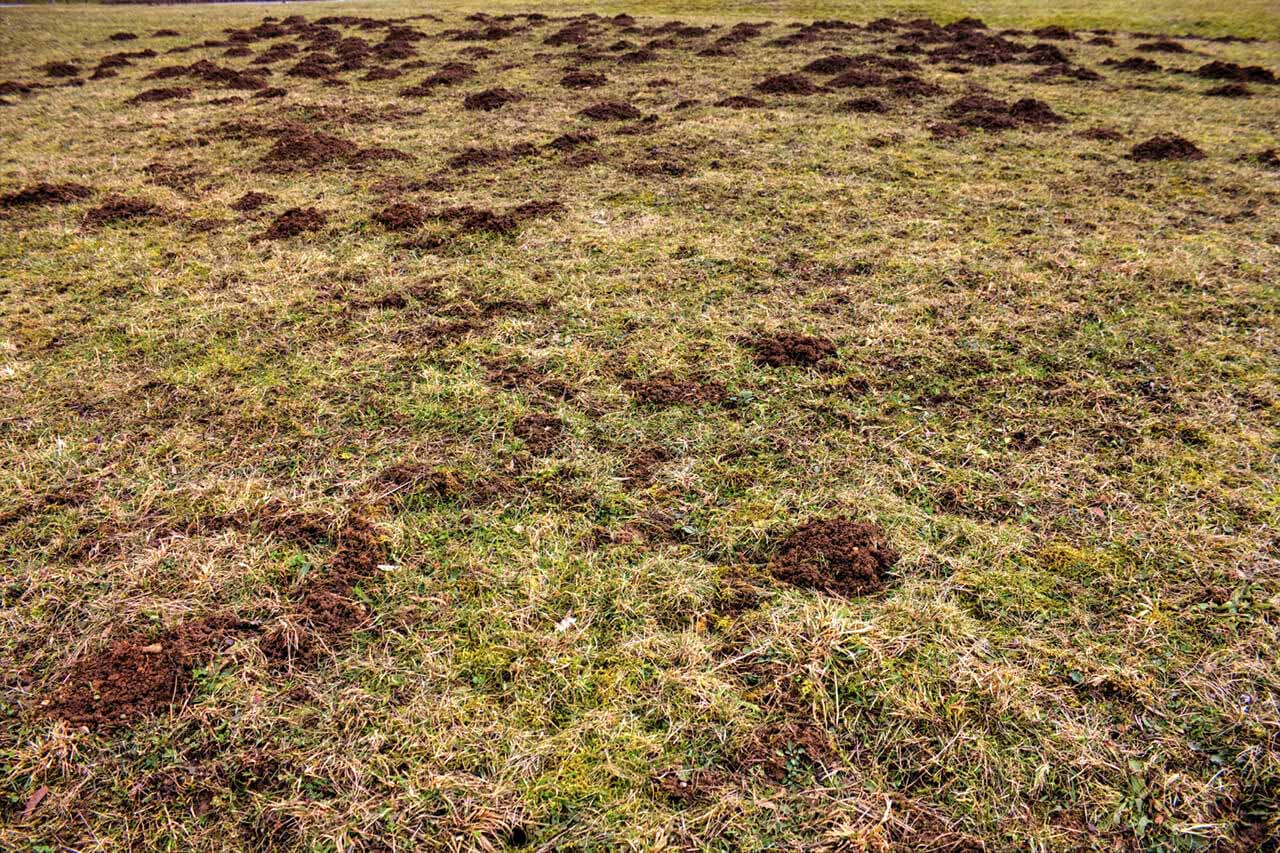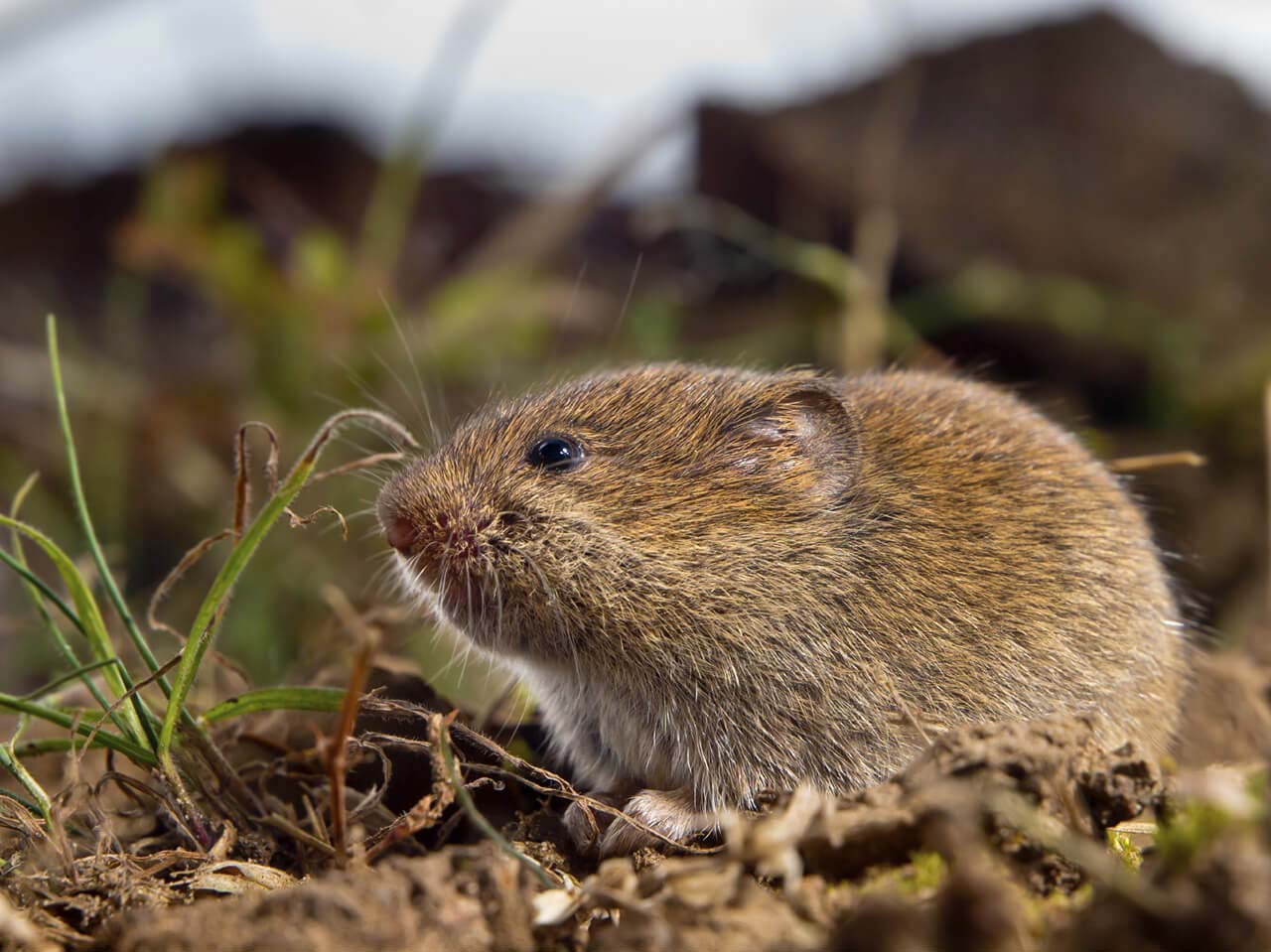How to ID and Kill Gophers
When ground-dwelling animal pests take up residence in your lawn, the results can be maddening. Gophers, moles and voles do extensive damage in a relatively short time, staying one step ahead of many homeowners. Without fast, effective action and the right animal-control products, your hard-won lawn can be destroyed. Victory over gophers, moles and voles depends on correctly identifying the culprit and meeting their challenges head on.
GETTING TO KNOW GOPHERS
Gophers are elusive critters that rarely show themselves, but their freshly-excavated earth leaves no doubt they're around. Identify gopher mounds by their distinctive crescent shape and the hidden entry locations. A gopher mound fans out around a plugged entry hole, with dirt concentrated alongside an underground tunnel. When viewed from the side, the mound slopes down toward the gopher's entry.

Like other true rodents, gophers have long incisors that grow continuously. Kept short by gnawing, their chisel-like teeth combine with large, powerful claws on the gopher's front feet. These short-tailed herbivores help themselves to plant parts above and below ground. They feed on roots — including your favorite root vegetables — and occasionally make a grab for plants above the surface. Gophers gnaw at underground wiring and irrigation lines, and they're known to pull plants by the roots right down into their tunnels.
With many species in the United States, gophers average between 6 and 12 inches in length and prevail everywhere except the Northeast. The highest concentrations exist in the country's western half, where year-round gopher activity peaks in spring and fall.1 Much gopher damage is too deep to be seen from above, until erosion during heavy rains or flooding reveals their extensive tunnels.
RECOGNIZING MOLES AT WORK
Moles, like gophers, leave mounds of dirt at the site of their entry holes, but they also leave raised feeding tunnels just below the soil's surface to zig-zag across your prized lawn. Unlike gopher mounds, conical mole hills appear balanced when viewed from the side and have entry holes directly in their center.

Usually thought of as rodents, moles are insectivores more closely related to bats than rats. Instead of prominent incisors, moles have teeth suited to a diet of earthworms, grubs and insects. Much mole damage to lawn grasses and other plants occurs as a by-product of feeding as moles displace plant roots in their shallow runways. Mole burrows and pathways extend deep below the hills and feeding tunnels.
Mole species can be found throughout the United States, with the heaviest concentrations in the Midwest and East. Active except in extreme cold weather, moles average between 6 and 8 inches in length.2 Know them by their tiny eyes, extended pointy snouts, short front legs and large mitt-like front feet, which they use to displace large amounts of soil.

READING TELL-TALE VOLE SIGNS
Also known as field or meadow mice, voles maintain networks of entry holes to underground dwellings. Instead of mounded dirt or raised tunnels, these true rodents build above-ground, trench-like runways between the holes, and keep them camouflaged with grass or snow. Once the grassy screen is raked away or snow cover melts, the brown, grassless paths are suddenly revealed.

Voles prefer a diet rich in lawn grass roots, flowering plants and tree bark. As winter approaches, they store seeds, tubers, rhizomes and your favorite flowering bulbs. Under protection of snow cover, these constantly-active pests feed on tree and shrub bark below the snow line, often girdling plants beyond repair. Voles prefer areas with heavy grass cover and natural debris. Eliminate grass cuttings and leaves, keep grass short and use protective tree guards to limit vole damage considerably.

Various vole species, present throughout the United States, average between 4 and 8 inches in length from nose to tail tip. Though similar in appearance to common mice, voles are generally larger and stockier, with partially hidden ears and shorter legs and tails.3
UNDERSTANDING ANIMAL-CONTROL OPTIONS
Effective animal-pest controls include fumigants, traps and bait. Choose the solution that fits your specific pests and preferences.
GOPHER, MOLE AND VOLE FUMIGANT CONTROLS
Fumigant controls, such as Amdro Gopher Gasser cartridges, release gases that travel through tunnel and burrow systems in lawns and gardens to kill the pests lurking beneath. Once ignited, the cartridge burns vigorously in the tunnel until it's completely spent. Fumigants are most effective in damp soils, which help keep gases concentrated in burrows and tunnels.
How to Use Amdro Gopher Gasser:
- Read and follow the "Prior to Application" label directions for the specific pest involved.
- Make sure the tunnel is active. For moles, step down on a feeding tunnel. For gophers, unplug the entry hole. If the tunnel is pushed up and repaired the next day or the entry hole is re-plugged, active gophers and moles are at play.
- Prepare the insertion hole. For moles, remove the center entry plug or probe the ground around the hole. For gophers, probe the soil 15 to 18 inches out from the side of the mound with the entry hole. When the probe goes into the soil with little or no resistance, you've found the runway. Carefully dig an opening large enough to quickly and easily insert a lit cartridge.
- Have non-combustible materials at hand to close the treated tunnel. Use rocks, soil or sod to close the hole after you insert the cartridge.
- Hold the Amdro Gopher Gasser cartridge away from your body and ignite the tip of the fuse with a match or lighter with a small flame. Never light the cartridge directly or within 2 inches of the fuse. Immediately insert the lit cartridge, fuse-end first, into the open runway. Work quickly; the minimum fuse burn time is five seconds when lit at the tip.Do not inhale the fumes.
- Close the opening with non-combustible materials and tamp it lightly. Look for visible gas escaping, and cover all openings. For large systems, repeat the process in another active run and then let Amdro Gopher Gasser do its work.
MECHANICAL GOPHER & MOLE TRAPS
An easy-to-use trap, such as Amdro Gopher Trap, eliminates problem lawn pests without gasses or baits. Trap voles with common mousetraps set sideways across a run and covered with a box that doesn't interfere with movement. Gophers and moles call for specially designed traps.
To use Amdro Gopher Trap:
- Locate the runways and tunnels in the same way you would if using a fumigant cartridge.
- Dig an opening into the tunnel, taking care not to let soil drop down inside. Make it large enough to insert and position the set trap lengthwise in the tunnel run. In large tunnels, set one trap in each direction.
- Have a board, stones or sod ready to cover the opening after the set trap is placed to prevent soil from falling in on the trap.
- Familiarize yourself with the trap parts by reading the product labeling. Don't set the trap until you're ready to place it.
- Hold the trap in one hand, then use the other hand to raise the trigger wire through the wires that form the trap's bottom.
- Hold the trigger wire above the trigger plate with the same hand. With the other hand, place your fingers underneath the trap and use your thumb to push the loop down to connect the catch around the loop. Keep applying pressure to the trigger wire to hold it on the loop.
- While keeping your hand on the trigger wire, lift up the trigger plate to put the trigger wire through the plate's hole.
- Push down on the trigger plate to keep the trigger wire in place. Then slowly release the trigger plate, with your hand safely at the base of the trap, which is now set.
- Position the trap in the tunnel runway, and cover the opening. Check the trap daily by carefully uncovering the area so soil doesn't fall onto the trap.
MOLE* & GOPHER BAIT CONTROLS
Pelleted bait products, such as Amdro Mole* & Gopher Bait, work when the targeted animal eats the bait and dies. Baits should be manually inserted into below-ground tunnels via the pest's entry hole or through an excavated opening into tunnels or feeding ridges.
How to use Amdro Mole* & Gopher Bait:
- Locate the entry holes to gopher mounds and molehills, and locate underground tunnels or raised feeding runs.
- Remove the side plug from the crescent-shaped gopher mound or the center plug from the conical mole hill. For tunnels and runways, carefully create an opening, taking care not to drop soil into the run.
- Use a long-handled spoon, dedicated to this use, to place 1 teaspoon of Amdro Mole* & Gopher Bait in each entry hole or runway opening.
- Close the opening with a rock or sod, being careful not to cover the bait with soil. Repeat only if activity recurs.
When animal pests strike, put a quick end to the madness and save your lawn from damage. Identify the pest behind your lawn problems, act quickly and partner with effective solutions from the Amdro line of animal control products. Repair bare spots and reclaim your lawn with the help of Pennington One Step Complete combination mulch, seed and fertilizer, and your lawn will soon be looking great again.
*Not for use on moles in CA, IN or NC
Amdro is a registered trademark of Central Garden & Pet Company. Pennington One Step Complete is a registered trademark of Pennington Seed, Inc.
Resources:
1. Case, Ronald M. and Jasch, Bruce A., “Prevention and Control of Wildlife Damage: Pocket Gophers," Internet Center for Wildlife Damage Management, 1994.
2. Henderson, F. Robert, “Prevention and Control of Wildlife Damage: Moles," Internet Center for Wildlife Damage Management, 1994.
3. O'Brien, John M., “Prevention and Control of Wildlife Damage: Voles," Internet Center for Wildlife Damage Management, 1994.



